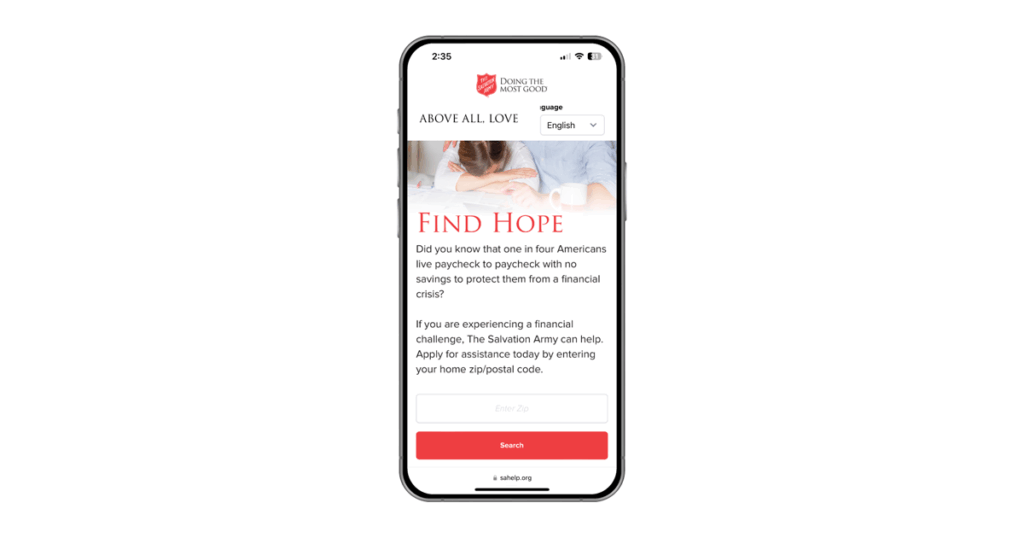Cyber Services: The Army Tests Digital Innovation with SAHelp
"SAHelp continues to improve the Army’s capacity for meeting human needs across the country."
Since its earliest days, The Salvation Army has largely viewed new technology positively. Frederick Booth-Tucker, an officer and son-in-law of William Booth, wrote in 1880: “Let science multiply its telegraphs, its steamers, its railways, and effect the increasing shrinkage of the world. Every new device shall make more swiftly possible the salvation of the nations, and shall bring them more immediately within reach of the heavenly influences that radiate from Calvary. The modern apostle of the Cross can afford to rejoice in each fresh discovery, and can turn to consider how best it can be utilized for the on great purpose to which he has consecrated his life.”
In its 160-year history, The Salvation Army has often made use of new technologies to achieve its mission and promote its message. The Salvation Army in Australia’s Limelight Department produced several films, including “Soldiers of the Cross” in 1900. The Joystrings, a contemporary music group born out of the International Training College, fused traditional gospel songs with rock’ n’ roll, sharing the UK Top 50 chart in 1964 with artists like the Beatles. In 1972, NASA astronaut John Young even took a Salvation Army flag on the Apollo 16 mission, making it the only non-national flag to ever be transported to the moon.
In March 2024, The Salvation Army of Columbus, GA began construction on its new 21,000-square-foot facility with space to house up to 17 homeless families. While the new facility promised to improve the Army’s ability to meet need in Columbus, its construction presented a challenge to the Army’s ongoing social services. “As we worked toward the construction of the Center of Hope, we were required to temporarily relocate our social services department to our corps building,” said Captain Andre Pereira of the Columbus corps. “Unfortunately, this facility is in a part of town with limited access to public transportation, creating substantial barriers for many of our clients.”
However, using technology, the Army found a solution, implementing online casework by using a new app called SAHelp. A situation that could have significantly hindered vital case work became an opportunity to make the Army’s service in Columbus more efficient. Captain Pereira concludes, “This transition has not only improved the client experience but also significantly eased the workload of our financial assistance staff. Each case is now processed in nearly half the time it once required.”
During the first COVID Christmas in 2020, Angel Tree, like many Army programs at the time, was struggling. With families unable to apply for Christmas assistance and donors unable to provide gifts, The Salvation Army went looking for a way to do online what it had done for decades in-person. “SAHelp came out of a need that was driven through COVID,” said Paul Booth, president and CEO of SAHelp’s developer, Data Paradigm Inc. (DPI). “The Salvation Army has an immense network of social services systems in place, and people and personnel in place, and it was met with a real challenge in 2020, and that is folks didn’t want to show up. Angel Tree was in Jeopardy, a great many of The Salvation Army services that it was providing were in jeopardy, and we were asked to put a remote system in place.”
The resulting web app was used by approximately 850 corps during that Christmas season and received excellent reviews. For many users, the implication of the success of that Angel Tree program was that the Army had more potential to realize in further embracing web-based services, which eventually led to the development of SAHelp — a revolutionary remote registration and case management tool for social services.
SAHelp allows the Army to facilitate a variety of social service programs, from food banks to rental assistance to emergency disaster services, over the web. Additionally, the app also enables the Army to maintain a longtime hallmark of its ministry: its holistic approach. The software often makes receiving and processing information for clients more efficient. Simultaneously, it also features built in text and video call features, allowing for intentional communication even when an in-person consultation isn’t possible.

The Paducah Corps in the Kentucky and Tennessee division serves seven counties. Their service area is two and a half hours from one side to the other by car. Before SAHelp, the corps would send one person once a month to do onsite visits with their clients in rural communities and keeping track of needs with pen and paper. Now those people living in remote areas can receive help through an app on their phones — 90% of clients use SAHelp on mobile devices — while they communicate via text, phone call or video chat.
“Many of the individuals we serve often spend limited funds on transportation just to reach our location in hopes of receiving help. SAHelp has significantly reduced these costs for our clients, while also enabling us to reach and assist more people overall,” said Captain Benny Carringer of the Paducah Corps. “In addition, SAHelp has become an invaluable tool in showcasing the impact of our services to other local nonprofits and service providers. It strengthens our community partnerships and fosters collaboration in the social services space.” Captain Carringer went on to praise SAHelp for allowing a hands-on, collaborative approach to engaging with clients, which he says makes a meaningful difference.
The National Capital Area Command recently experienced a common challenge situation faced by some larger commands. The local utility company Pepco reached out with an offer to fund $5 million of utility bill credits to be distributed to 16,000 applicants in need. The timeframe required for the funding presented potential difficulties with scaling up the program to serve the target number of recipients. However, due to the success of the SAHelp implementation at NCAC over the previous year, they were able to immediately put a solution in place to service those applicants in a matter of weeks and not months — all without any lapses or declines with their existing social services programs.
The technological optimism of the Army’s early days extends to the present as various systems and digital tools support The Salvation Army’s day-to-day services. Key to realizing new technological capabilities is the Army’s reliance on developers that assist with creating applications specific for the Army’s use, developers like DPI. DPI made SAHelp customizable and adaptable to a location’s needs. “It’s like a smorgasbord. They can take a little of this, they can put that back there,” says Paul Booth. “Use it, don’t, it’s up to you — it’s entirely your call.”
The Salvation Army doesn’t need cutting-edge technology to be on the cutting-edge of ministry. Nevertheless, SAHelp continues to improve the Army’s capacity for meeting human needs across the country. Having partners like Data Paradigm builds upon the long legacy of Salvationists venturing into new technologies for the sake of God’s mission in The Salvation Army. Serving every US zip code and 134 countries at-large, The Salvation Army contextualizes the mission wherever it is present with each location acting as a kind of missional incubator. What works in one context may not be conducive or necessary in another. With a variety of approaches, technologies and tools, the aim of The Salvation Army remains the same: to preach the Gospel of Jesus Christ and to meet human needs in His name.







